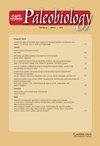舌骨是创新的约束吗?鱼形海洋四足动物趋同驱动摄食的研究
IF 2.6
2区 地球科学
Q2 BIODIVERSITY CONSERVATION
引用次数: 3
摘要
舌骨器官对于海洋四足动物的水下进食是必不可少的,但目前尚不清楚这个复合体是否像其他特征(如齿列或运动)一样趋同进化。在这里,我们比较了眼龙类鱼龙和齿鲨类鲸类这两种整体体型相似的类群中骨化的舌骨元素,以了解舌骨元素在进食时是否有趋同的迹象。我们检查了三种类型的数据(大小、形态和内部骨微观结构)在眼龙和齿牙兽分类群中,这些元素被保存。我们的数据显示,鱼龙从未经历过进食模式的转变,这可能表明它们的舌骨器官从未适应吸食。此外,这两个动物群体的内部微观结构也不同;齿龙的整体结构不太紧凑,眼龙鱼龙的外层更紧凑的鞘内有松质状的内锥体。这些差异可能被解释为对不同喂养模式的生物力学适应。因此,与鲸目动物相比,鱼龙的舌骨变化较少,更多的是作为一种限制进食创新的因素,并且经历了更长的时间跨度(超过150万年)。本文章由计算机程序翻译,如有差异,请以英文原文为准。
Is the hyoid a constraint on innovation? A study in convergence driving feeding in fish-shaped marine tetrapods
The hyoid apparatus is essential for underwater feeding in marine tetrapods, but it is unclear whether this complex has evolved as convergently as other traits, such as dentition or locomotion. Here we compare the ossified hyoid elements in ophthalmosaurid ichthyosaurs and odontocete cetaceans, two groups with an overall similar body shape, to understand whether the hyoid elements show any signs of convergence in the context of feeding. We examined three types of data (size, morphology, and internal bone microstructure) in ophthalmosaurid and odontocete taxa in which these elements are preserved. Our data show that ichthyosaurs never experienced a shift in feeding mode, which might indicate that their hyoid apparatus never adapted to suction feeding. Also, the internal microstructure of the two animal groups differs; where the odontocetes have an overall less compact structure, ophthalmosaurid ichthyosaurs have cancellous inner cones in an outer, more compact sheath. These differences are likely explained as biomechanical adaptations to different feeding modes. Thus, the hyoid changed less and acted more as a constraint for feeding innovation in ichthyosaurs compared with cetaceans, and through a much longer time span (more than 150 Myr).
求助全文
通过发布文献求助,成功后即可免费获取论文全文。
去求助
来源期刊

Paleobiology
地学-古生物学
CiteScore
5.30
自引率
3.70%
发文量
38
审稿时长
>12 weeks
期刊介绍:
Paleobiology publishes original contributions of any length (but normally 10-50 manuscript pages) dealing with any aspect of biological paleontology. Emphasis is placed on biological or paleobiological processes and patterns, including macroevolution, extinction, diversification, speciation, functional morphology, bio-geography, phylogeny, paleoecology, molecular paleontology, taphonomy, natural selection and patterns of variation, abundance, and distribution in space and time, among others. Taxonomic papers are welcome if they have significant and broad applications. Papers concerning research on recent organisms and systems are appropriate if they are of particular interest to paleontologists. Papers should typically interest readers from more than one specialty. Proposals for symposium volumes should be discussed in advance with the editors.
 求助内容:
求助内容: 应助结果提醒方式:
应助结果提醒方式:


